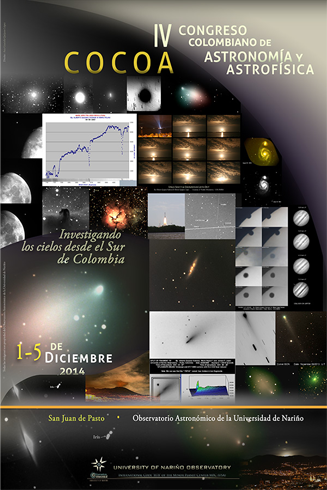Estudio de Estructuras Espirales en Modelos de Discos Galácticos
Contenido principal del artículo
Resumen
Con el fin de entender el mecanismo físico subyacente a brazos no estacionarios de galaxias espirales en discos galácticos, se ejecutó una serie de simulaciones de N-cuerpos con 1.2 y 8 millones de partículas.
Las condiciones iniciales fueron escogidas siguiendo los modelos de Kuijken-Dubinski. En este trabajo se presenta una sub-muestra de todas las simulaciones, en la cual se cambiaron la dispersión de velocidad radial y la escala de altura de la componente discoidal. Se analizó el crecimiento de la estructura espiral usando la Transformada de Fourier unidimensional (FT1D) y bidimensional (FT2D). Se muestran gráficos de la amplitud de Fourier |A(p;m)| como función del tiempo, el cual muestran claramente el mecanismo del swing amplification actuando en los discos estelares de las simulaciones. Por otra parte, hay un modelo que forma una barra. En el sistema de referencia de la barra se clasificó geométricamente 3 tipos de órbitas: órbitas compactas (OC), órbitas que soportan la barra (OB) y órbitas atrapadas en los puntos lagrangianos (OL). El número de órbitas OB y OL aumentan considerablemente con la formación de la barra, conformando alrededor del 20% de la masa total del disco.
Palabras Claves: galaxias: cinemática y dinámica, galaxias: espirales, galaxias: estructura, inestabilidades, órbitas.
Abstract
In order to understand the physical mechanism underlying non-steady stellar spiral arms in disk galaxies, we perform a series of three-dimensional N-body simulations with 1.2 and 8 million particles. The initial conditions were chosen to follow Kuijken-Dubinski models. In this work, we present the results of a sub-
sample of our simulations set, in which we changed the disk radial velocity dispersion R and disk scale height zd of the disk component. We analyzed the growth of spiral structure using one dimensional (FT1D) and a two-dimensional Fourier Transform (FT2D) on a basis of logarithmic spirals. We have plotted the
amplitudes of the Fourier modes as a function of time. These plots demonstrate the swing amplification mechanism acting in the stellar disk. In a model where a bar is formed, we studied the stars orbits in the bar reference frame. We were able to geometrycally classify three types of orbits: compacts, bar support-
ing, and orbits trapped in the lagrangian points L4 and L5. The number of these orbits grows considerably after the bar formation, catching around 20% of the total disk mass.
Keywords: galaxies: kinematics and dynamics, galaxies: spiral, galaxies: structure, instabilities, orbits.

